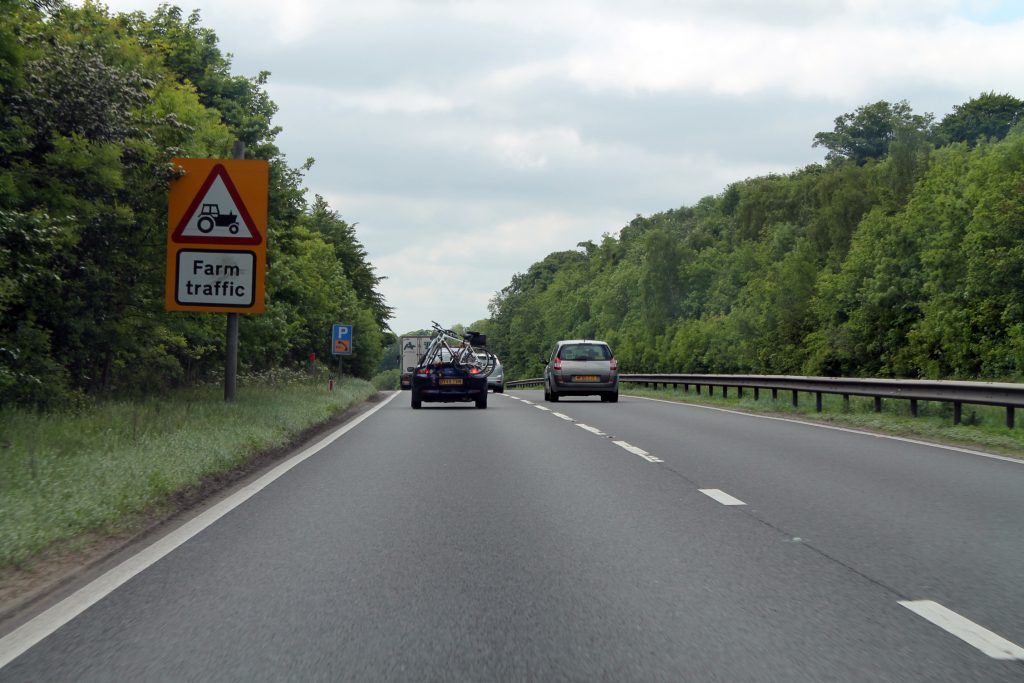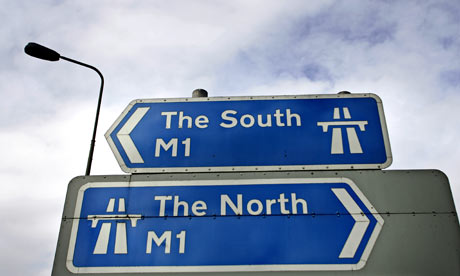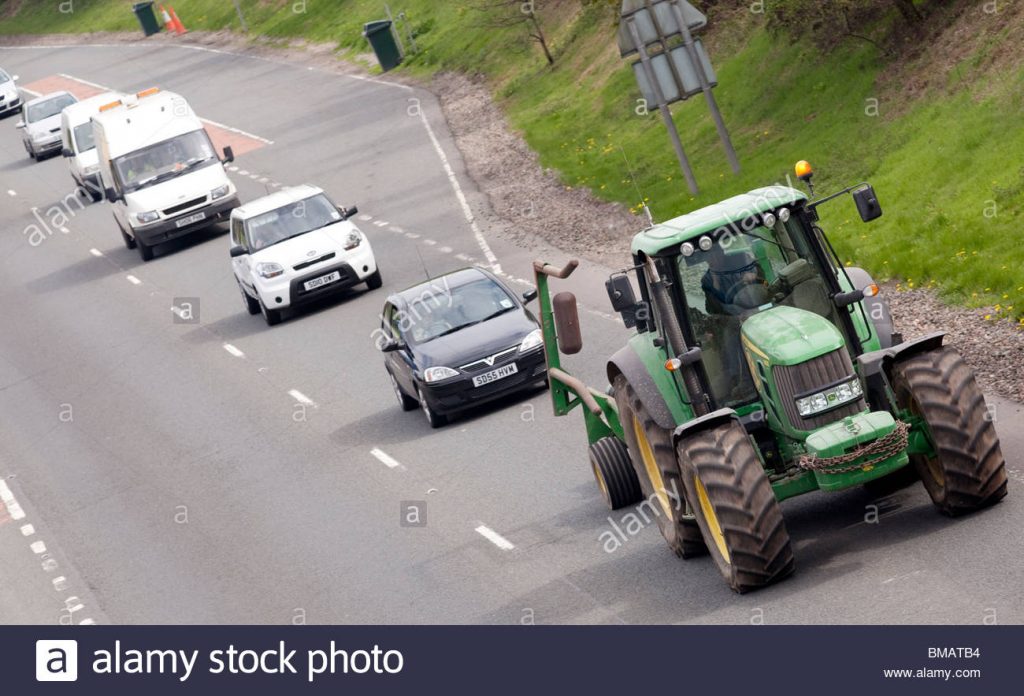Guidare in Inghilterra: verso nord
Gli italiani che programmano un viaggio in auto nel Regno Unito hanno una grande preoccupazione, quella di dover guidare sull’ “altro” lato. Io avevo un piano: avrei seguito la macchina davanti a me (il che non ha sempre senso, lo ammetto) e mi sarei ricordata che il mio corpo avrebbe sempre dovuto viaggiare sul lato della strada, accanto al marciapiede. Il discorso destra-sinistra mi toccava poco, lasciate che vi racconti un segreto: non riesco a distinguere bene la destra dalla sinistra! Sono destromane ma il mio occhio dominante è il sinistro, l’ho scoperto praticando il tiro a volo. La dominanza crociata rende molto più complicata qualsiasi disciplina sportive che preveda tiri di precisione ma, soprattutto, rende difficile differenziare la destra dalla sinistra. Alla fine, ragionandoci, capisco dove stanno l’una e l’altra nello spazio, ma non è immediato. Il problema della destra e della sinistra ricompare anche ogni volta che devo sganciare il cane indirizzandolo su un determinato lato o, peggio ancora, quando l’addestratore che mi segue mi urla, stando alle mie spalle (o peggio di fronte – devo ri-ragionare la destra e la sinistra spazialmente) in che direzione inviare il cane.
Sebbene induca spesso confusione e incomprensioni, la mia relazione complicata con i lati, è diventata un punto di forza quando mi sono ritrovata a guidare sul lato “sbagliato” (nel testo il lato britannico verrà indicato come “l’altro lato” o il “lato sbagliato” perché, come ho spiegato poco sopra, fatico a distinguere i due lati). Raggiunta Folkestone, mi sono limitata a seguire l’auto che mi procedeva, sentendomi subito a mio agio. C’era molto traffico, ma un tipo di traffico che definirei educato, placido e mansueto anche quando incolonnato per il Dartford Crossing. Il Dartford Crossing è qualcosa di peculiare: all’andata, verso nord, era un tunnel; al ritorno, verso sud era un ponte. Ancor più strano è però il fatto che i titolari del Dartford Crossing pretendano del denaro per l’attraversamento, ma non diano agli automobilisti la possibilità di pagare. Mi era stato detto che avrei dovuto sborsare alcune sterline,h ma nessun Dartford-Elfo è venuto a chiedermele, né ho incontrato barriere e caselli in cui versare le mie monetine. Quindi… ho attraversato senza pagare, non perché volessi fare la furba ma perché semplicemente non c’era alcun modo per pagare! Mi è stato detto che verranno a stanarmi in Italia, minacciando multe, vengano pure, racconterò quel che è successo: nessuno mi aveva detto che avrei potuto pagare in anticipo con la carta di credito o, al limite, pagare online entro la mezzanotte del giorno dell’attraversamento. Probabilmente, prima che la Brexit diventi veramente la Brexit, qualche europeo porterà la questione in qualche sede giudiziaria europea: come è possibile pretendere dai clienti un pagamento e non offrire loro la possibilità di pagare? Tutto ciò mi ricorda il viaggio di Alice nel Paese delle Meraviglie.
Comunque, andiamo versi nord. Quello che si incontra dopo è Londra, o meglio, un’autostrada che gira attorno a Londra. L’idea di affrontare il traffico londinese può spaventare molti stranieri, ma non coloro che sono avvezzi a guidare sulla tangenziale di Milano. Chi sopravvive abitualmente al traffico milanese nelle ore di punta è pronto a tutto. Prendiamo la A, un’autostrada che conosco bene e che collega Genova a Milano. Attorno sette del mattino, giunti in prossimità di Milano, succede di tutto: per esempio una è normale venire superati sulla destra (ricordo che in Italia è proibito superare sulla destra) da qualcuno lanciato a 160 km orari. Il milanese deve arrivare in ufficio puntuale, a Milano si va veloci, punto e basta, tutti devono correre, anche se non ne hanno motivo. Altrettanto normali sono i milanesi imbruttiti che, in prossimità della barriera autostradale di Milano, anziché rallentare accelerano! I londinesi, seppur numerosi e indaffarati, non guidano come il milanese medio: guidare attorno a Londra è stato incredibilmente semplice.
In prossimità di Stanstead, ho avvertito la necessità di reperire un benzinaio così, seguendo le scritte “stazione di servizio”, sono finita in un grazioso villaggio, con un grazioso country club e nessun benzinaio in vista. Girando attorno alla rotonda per una ventina di volte, ho poi notato un centro commerciale provvisto di benzinaio. Non ho nulla contro i centri commerciali ma, normalmente, in Italia i benzinai e gli Autogrill si trovano SULL’autostrada, non sono necessarie cacce al tesoro.
Risolto il problema benzina, ho continuato a guidare verso “The North”, come scritto sui cartelli, familiarizzando con I lati oscuri dell’A1. L’A1, che in certi tratti viene chiamata M1, dovrebbe essere un’autostrada ma il suo status è un po’ vago: a tratti lo è a tratti non lo è, spiegano i britannici, ma la cosa resta di difficile comprensione per uno straniero. In qualche maniera sembra un’autostrada, certo non delle migliori, ma pur sempre un’autostrada. Aspettate un attimo: cosa fa quel deficiente-c@gli@ne, imbecille – è impazzito e taglia di traverso l’autostrada? Ero sinceramente scioccata: nel mio imperfettissimo paese, in cui nessuno va in galera, per una cosa simile rischi di andarci. Ma… Oddio, eccone un altro fare lo stesso pochi chilometri più in là, è un’abitudine che lascia sgomenti. Prestando attenzione, ho in seguito notato cartelli e “punti letali” specificamente pensati per consentire questi comportamenti. Non riesco ancora a credere che fare inversioni a U e attraversare le autostrade sia legale, così come fatico ad accettare la possibilità che i pedoni attraversino (Attenzione, attraversamento pedoni! Dicono certi cartelli) o che un trattore o peggio, un carretto trainato da un cavallo, appaiano di punto in bianco. Il Farm Traffic descritto dai cartelli esiste, e si materializza nei peggiori punti e incalza nei momenti meno opportuni. In alcuni tratti dell’A1 ci sono lavori in corso che obbligano a procedure con lentezza ma questa strada, come tutte le strade britanniche, è gratuita. I guidatori lassù non pagano pedaggi ma, usando la loro rete viaria, si capisce il perché. Le nostre autostrade sono costose, eccessivamente costose, solo alcuni tratti della famigerata A3 Salerno-Reggio Calabria, dato lo squallore, sono gratuiti. Non mi resta che provarla e confrontare!
Il Farm Traffic descritto dai cartelli esiste, e si materializza nei peggiori punti e incalza nei momenti meno opportuni. In alcuni tratti dell’A1 ci sono lavori in corso che obbligano a procedure con lentezza ma questa strada, come tutte le strade britanniche, è gratuita. I guidatori lassù non pagano pedaggi ma, usando la loro rete viaria, si capisce il perché. Le nostre autostrade sono costose, eccessivamente costose, solo alcuni tratti della famigerata A3 Salerno-Reggio Calabria, dato lo squallore, sono gratuiti. Non mi resta che provarla e confrontare!
Comunque, alla fine, sono arrivata a Woodland.